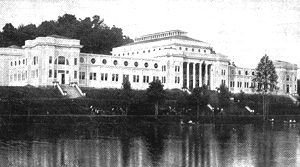
Appalachian Exposition of 1910
The Appalachian Exposition of 1910 was held in Knoxville from September 12 to October 12, 1910. Although large expositions were commonplace at the turn of the century, and county, regional, and state agricultural fairs predated this Knoxville convention, the Appalachian Exposition of 1910 was the first one held in the southern Appalachian region. The intention of the fair was to demonstrate progress in southern industry and commerce. Moreover, it promoted the conservation of the region’s natural resources, advocating their responsible exploitation for utilitarian (serving the public good) rather than aesthetic or ecological purposes. The fair’s broad message applied the popular idea of a “New South” to southern Appalachia: the social and economic modernization of the South was to imitate and surpass northern prosperity. Through the promotion of government intervention and long-term investments in the service of conservation, the exposition’s founders beckoned the more conservative businessmen of Knoxville to contribute to the creation of a grand industrial city.
Director general and secretary of the Knoxville Commercial Club William M. Goodman first envisioned the Appalachian Exposition in 1900. Not until 1908, however, when a massive publicity campaign rallied public support behind the event and Chilhowee Park was chosen as its site, did the club fully embrace the idea. In 1909 the Appalachian Exposition Company was established with local businessman William J. Oliver as president. Oliver and other company officers were responsible for the event’s planning and management.
Exposition exhibits at the fairgrounds were housed in separate buildings. The eighty-thousand-square-foot Main Building held a myriad of displays promoting hardwood products and agricultural machinery and included various state and county exhibits. Exhibits in the Women’s Building included contests for the best household products, such as needlework or canning items, and urged the adoption of “domestic science,” the application of efficient time-saving techniques to housework, cooking, and child care. The Black Department, held in a building erected by the local black community, was designated to present the progress of African Americans to visitors. By separating the Women’s and African American departments from the rest of the fair, traditional boundaries were reinforced. But members of each group viewed their exhibits as significant boosts to their collective self-worth. Three cabins on the fairgrounds portrayed Appalachian highlanders as churlish and peculiar, but more importantly, also as a group with the potential to participate in regional progress. The midway of the exposition hosted attractions ranging from “Muhall’s Wild West Show” to “The Infant Incubator.” Aeroplanes at the fair were the first to be seen in East Tennessee. Former president Theodore Roosevelt visited the fair and praised the promise of the fair and of the region.
The success of the 1910 fair led to the 1911 Appalachian Exposition and the 1913 National Conservation Exposition. These fairs preached, with a few modifications, the same New South message. The fairs had beneficial short-term effects, such as profitability and publicity, but failed to achieve their ultimate goal, the transformation of Knoxville into a model New South city.



